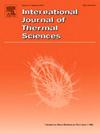Performance of serrated finned plate exhaust heat exchangers coupled with soot deposition characteristics
IF 4.9
2区 工程技术
Q1 ENGINEERING, MECHANICAL
International Journal of Thermal Sciences
Pub Date : 2025-04-25
DOI:10.1016/j.ijthermalsci.2025.109952
引用次数: 0
Abstract
In exhaust waste heat recovery (WHR) heat exchangers, the deposition of soot particles on the heat transfer surface significantly affects the performance of the heat exchanger. In this paper, the two-fluid model (TFM) for particle deposition was improved, and the performance of serrated finned plate exhaust heat exchanger considering soot deposition was studied. In the model, the real wall temperature distribution was also considered, instead of the simplified constant wall temperature assumption. The particle wall adhesion energy criterion and particle adhesion probability were also considered. Using the model, the effects of fin spacing, fin height and fin interrupted length on particle deposition characteristics and thermal-hydraulic performance of the serrated finned plate heat exchanger were studied. The results show that when the initial kinetic energy of soot particles exceeds the critical value, the adhesion probability decreases with the increase of initial kinetic energy. Moreover, larger particles exhibit a lower critical value, indicating that smaller particles are more likely to stick on the heat transfer surface. After 4 h deposition of soot particles, the comprehensive performance j/f1/3 of the heat exchanger decreased by 24.78 %–31.94 %. The deposition of soot particles is more significant in serrated fin heat transfer structures with large fin spacing, large fin height, and small fin interrupted length. In addition, the particle deposition distribution inside the heat exchanger has also been studied. More deposition occurs in the front and back regions of the fins, and the amount of deposition inside the heat exchanger gradually decreases along the direction of exhaust flow.
考虑烟尘沉积特性的锯齿翅片板式排热交换器性能
在废气余热回收(WHR)换热器中,烟灰颗粒在传热表面的沉积严重影响换热器的性能。本文对颗粒沉积的双流体模型(TFM)进行了改进,研究了考虑烟尘沉积的锯齿翅片板式排气换热器的性能。模型中还考虑了实际壁面温度分布,而不是简化的壁面温度恒定假设。同时考虑了粒子壁面粘附能准则和粒子粘附概率。利用该模型,研究了翅片间距、翅片高度和翅片间断长度对锯齿翅片板式换热器颗粒沉积特性和热工性能的影响。结果表明:当烟尘颗粒的初始动能超过临界值时,随着初始动能的增大,附着概率减小;颗粒越大,临界值越低,说明颗粒越小,越容易粘在传热表面。烟尘颗粒沉积4 h后,换热器的综合性能j/f1/3下降了24.78% ~ 31.94%。在大间距、大高度、小间断长度的锯齿状翅片换热结构中,烟尘颗粒的沉积更为明显。此外,还对换热器内颗粒沉积分布进行了研究。在翅片的前后区域沉积较多,且换热器内沉积量沿排气方向逐渐减少。
本文章由计算机程序翻译,如有差异,请以英文原文为准。
求助全文
约1分钟内获得全文
求助全文
来源期刊

International Journal of Thermal Sciences
工程技术-工程:机械
CiteScore
8.10
自引率
11.10%
发文量
531
审稿时长
55 days
期刊介绍:
The International Journal of Thermal Sciences is a journal devoted to the publication of fundamental studies on the physics of transfer processes in general, with an emphasis on thermal aspects and also applied research on various processes, energy systems and the environment. Articles are published in English and French, and are subject to peer review.
The fundamental subjects considered within the scope of the journal are:
* Heat and relevant mass transfer at all scales (nano, micro and macro) and in all types of material (heterogeneous, composites, biological,...) and fluid flow
* Forced, natural or mixed convection in reactive or non-reactive media
* Single or multi–phase fluid flow with or without phase change
* Near–and far–field radiative heat transfer
* Combined modes of heat transfer in complex systems (for example, plasmas, biological, geological,...)
* Multiscale modelling
The applied research topics include:
* Heat exchangers, heat pipes, cooling processes
* Transport phenomena taking place in industrial processes (chemical, food and agricultural, metallurgical, space and aeronautical, automobile industries)
* Nano–and micro–technology for energy, space, biosystems and devices
* Heat transport analysis in advanced systems
* Impact of energy–related processes on environment, and emerging energy systems
The study of thermophysical properties of materials and fluids, thermal measurement techniques, inverse methods, and the developments of experimental methods are within the scope of the International Journal of Thermal Sciences which also covers the modelling, and numerical methods applied to thermal transfer.
 求助内容:
求助内容: 应助结果提醒方式:
应助结果提醒方式:


